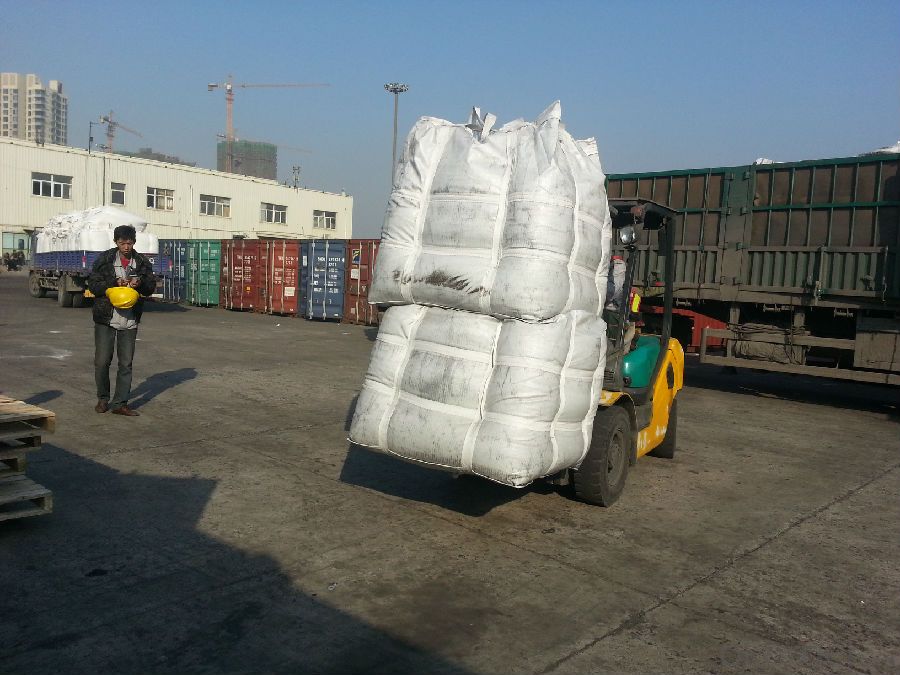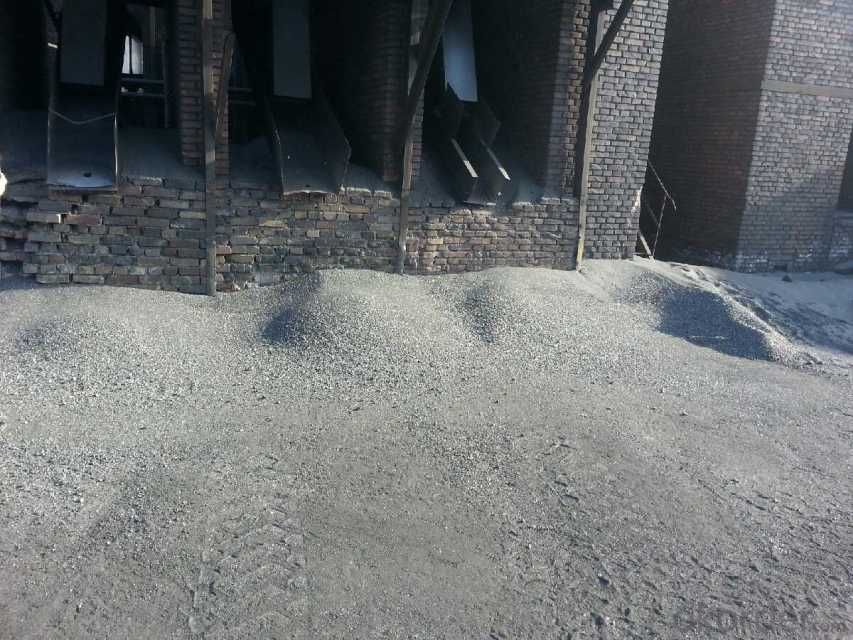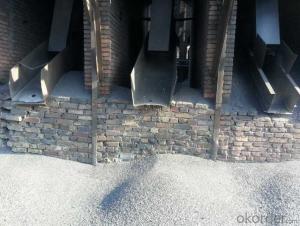FC92 Charge Coke with good and stable quality
- Loading Port:
- Tianjin
- Payment Terms:
- TT OR LC
- Min Order Qty:
- 20 m.t.
- Supply Capability:
- 3000 m.t./month
OKorder Service Pledge
OKorder Financial Service
You Might Also Like
Packaging & Delivery
25kgs/50kgs/1ton per bag or as buyer's request
Specifications
Calcined Anthracite
Fixed carbon: 90%-95%
S: 0.5% max
Size: 0-3. 3-5.3-15 or as request
Advantage and competitive of caclined anthracite:
1. strong supply capability
2. fast transportation
3. lower and reasonable price for your reference
4.low sulphur, low ash
5.fixed carbon:95% -90%
6..sulphur:lower than 0.3%
It used the high quality anthracite as raw materials through high temperature calcined at over 2000 by the DC electric calciner with results in eliminating the moisture and volatile matter from anthracite efficiently, improving the density and the electric conductivity and strengthening the mechanical strength and anti-oxidation. It has good characteristics with low ash, low resistvity, low sulphur, high carbon and high density. It is the best material for high quality carbon products.
General Specification of Calcined Anthracite:
| FC % | 95 | 94 | 93 | 92 | 90 |
| ASH % | 4 | 5 | 6 | 6.5 | 8.5 |
| V.M. % | 1 | 1 | 1 | 1.5 | 1.5 |
| S % | 0.3 | 0.3 | 0.3 | 0.35 | 0.35 |
| MOISTURE % | 0.5 | 0.5 | 0.5 | 0.5 | 0.5 |
Pictures



- Q:What are the impacts of carbon emissions on ecosystems?
- Ecosystems are significantly affected by carbon emissions, and their consequences can be observed at various levels of the food chain. One of the primary effects is the modification of the climate, as carbon emissions contribute to global warming and climate change. This alteration in temperature and weather patterns can disturb ecosystems and result in the depletion of biodiversity. Moreover, increased carbon emissions also play a role in ocean acidification, a process in which seawater absorbs carbon dioxide, leading to a reduction in pH levels. This can have harmful impacts on marine life, especially organisms that possess calcium carbonate shells like corals, mollusks, and specific plankton species. As the acidity of the oceans intensifies, it becomes more difficult for these organisms to produce and maintain their protective shells, ultimately causing a decline in their populations. Additionally, carbon emissions have the potential to influence the distribution and behavior of species. With rising temperatures, certain habitats become unsuitable for some species, compelling them to either migrate or adapt to new conditions. This can disrupt the fragile equilibrium of ecosystems, as some species may struggle to find sufficient resources or face heightened competition for limited resources in their new environments. Furthermore, carbon emissions have a significant impact on the frequency and intensity of extreme weather events such as hurricanes, droughts, and wildfires. These occurrences can result in the destruction of habitats, loss of vegetation, and displacement of species, ultimately affecting the overall well-being and stability of ecosystems. In conclusion, the effects of carbon emissions on ecosystems are profound and far-reaching. It is imperative to reduce these emissions and transition to cleaner sources of energy in order to mitigate these consequences and safeguard the delicate balance of our natural world.
- Q:Carbon 60 related information
- Discovery and structural features of carbon sixtyIn October 7, 1996, the Royal Swedish Academy of Sciences decided to award the 1996 Nobel prize for chemistry to Robert FCurl, Jr (USA), Harold WKroto (UK) and Richard ESmalley (USA) in recognition of their discovery of C60.In early September 1995, Rice University of Texas Smalley lab, Kroto etc. in order to form the process simulation of carbon clusters N near the red giant in the atmosphere, the laser gasification experiment of graphite. They found that there is a series formed by an even number of carbon atoms from the molecular mass spectra, which have a 20~25 times larger than the other peak peak, the peak corresponding to the quality of the number of molecules formed by 60 carbon atoms.What structure of C60 molecules can be stabilized? Layered graphite and diamond tetrahedral structure exists in the form of two kinds of stable carbon, when 60 carbon atoms arranged in any of them, there will be many dangling bonds, will be very lively, not showing the mass signal so stable. This shows that the C60 molecule has a completely different structure from graphite and diamond. Inspired by architect Buckminster Fuller composed of pentagons and hexagons dome building, Kroto thinks that C60 is composed of 60 spherical carbon atoms with 32 sides, i.e. 12 pentagons and 20 hexagons, so there is no double bond in C60 molecule.In C60 molecules, each carbon atom with three carbon atoms in SP2 hybrid orbitals and the adjacent connected, a hybrid P track did not participate in the remaining in the C60 shell periphery and the cavity formed spherical PI key, thus having aromatic. In honor of Fuller, they proposed the use of Buckminsterfullerene to name C60. Later, all the molecules containing even numbered carbon, including C60, were called Fuller, and the name was fullerene.
- Q:What is the relationship between carbon and climate change?
- The carbon-climate relationship mainly relies on the role of carbon dioxide (CO2) as a greenhouse gas. CO2 naturally exists in the Earth's atmosphere and is indispensable for maintaining a livable climate by ensnaring heat from the sun and preventing its escape into space. Nevertheless, human activities, particularly the combustion of fossil fuels like coal, oil, and natural gas, have substantially raised the levels of CO2 in the atmosphere. The surplus CO2 functions as an added layer, capturing more heat and resulting in a phenomenon called the greenhouse effect. This surge in greenhouse gases, including CO2, methane, and nitrous oxide, is causing global temperatures to climb and consequently leading to climate change. The elevated temperatures disturb weather patterns, leading to more frequent and intense extreme weather events such as hurricanes, droughts, heatwaves, and heavy rainfall. Moreover, the excessive CO2 in the atmosphere is also being absorbed by the oceans worldwide, resulting in ocean acidification. This process modifies the chemical composition of seawater, which has adverse effects on marine life, coral reefs, and other ecosystems. It is crucial to reduce carbon emissions and transition to renewable energy sources to mitigate climate change. By diminishing the amount of CO2 released into the atmosphere, we can decelerate and potentially reverse the detrimental impacts of climate change. Additionally, efforts to preserve and restore forests, which act as carbon sinks by absorbing CO2, are also essential in addressing the carbon-climate relationship.
- Q:What are the sources of carbon emissions?
- Carbon emissions are primarily caused by human activities that involve the burning of fossil fuels such as coal, oil, and natural gas. The largest source of carbon emissions is the burning of fossil fuels for electricity generation, transportation, and industrial processes. Power plants that burn coal and natural gas account for a significant portion of carbon emissions, as do vehicles that run on gasoline and diesel fuels. Industrial processes, particularly in sectors such as cement production and steel manufacturing, also contribute to carbon emissions. These processes release carbon dioxide (CO2) during the chemical reactions involved in the production of these materials. Deforestation and land-use changes are another significant source of carbon emissions. When forests are cleared, the carbon stored in trees is released into the atmosphere as CO2. Additionally, the loss of forests reduces the Earth's capacity to absorb CO2 through photosynthesis, exacerbating the problem. Agricultural activities, particularly livestock farming, contribute to carbon emissions through the release of methane (CH4) from the digestive systems of animals and the decay of organic matter. The use of synthetic fertilizers in agriculture also contributes to carbon emissions as they release nitrous oxide (N2O), a potent greenhouse gas. Other sources of carbon emissions include waste management practices, particularly the decomposition of organic waste in landfills, and certain industrial processes that release other greenhouse gases such as hydrofluorocarbons (HFCs) and sulfur hexafluoride (SF6). It is important to note that while carbon emissions are predominantly caused by human activities, natural processes such as volcanic eruptions and wildfires also release carbon dioxide into the atmosphere. However, these natural sources are significantly smaller compared to human-induced emissions.
- Q:What are the consequences of increased carbon emissions on human migration patterns?
- Increased carbon emissions can have significant consequences on human migration patterns. One major consequence is the displacement of populations due to the impacts of climate change, such as rising sea levels, extreme weather events, and loss of agricultural productivity. This can lead to forced migration, as people seek safer and more habitable areas. Additionally, the impacts of climate change can exacerbate existing social, economic, and political tensions, potentially leading to conflict and further displacement. Furthermore, the strain on resources and infrastructure caused by increased carbon emissions can also contribute to migration, as communities may struggle to meet basic needs. Overall, increased carbon emissions can disrupt human migration patterns and create complex challenges for individuals, communities, and governments worldwide.
- Q:How does carbon impact air quality?
- The release of carbon dioxide (CO2) and other carbon-based pollutants into the atmosphere can significantly affect air quality. When fossil fuels like coal, oil, and natural gas are burned, they emit large amounts of carbon dioxide, a greenhouse gas that contributes to climate change. This increase in carbon dioxide levels in the atmosphere causes the Earth's surface to warm, leading to adverse effects on air quality. Moreover, incomplete combustion of fossil fuels and other organic materials can also release carbon-based pollutants like carbon monoxide (CO) and volatile organic compounds (VOCs). These pollutants have detrimental effects on human health and can contribute to the formation of ground-level ozone, which is a major component of smog. Breathing in ozone can cause respiratory problems, lung damage, and worsen existing respiratory conditions such as asthma. Additionally, burning fossil fuels, biomass, and other organic matter releases carbon particles known as black carbon or soot. These particles directly impact air quality by absorbing sunlight and reducing visibility. When inhaled, they can penetrate deep into the lungs, leading to respiratory issues and potential long-term health problems. To improve air quality and mitigate the negative impacts on human health and the environment, it is crucial to reduce carbon emissions. This can be achieved by transitioning to cleaner and more sustainable energy sources, such as renewable energy. Additionally, implementing stricter regulations and emission standards for industries and vehicles can contribute to reducing carbon pollution and improving overall air quality.
- Q:Who can explain that bare feet on fire carbon don't burn feet?
- First coated with Yunnan Baiyao to run, injury probability can be greatly reduced, we have such a custom inside the village, and then those children have to paint up and run, generally nothing
- Q:How does carbon affect the quality of soil?
- Carbon plays a crucial role in determining the quality of soil. When organic matter, such as dead plants and animals, decomposes, it releases carbon into the soil. This process is known as carbon sequestration, and it is essential for maintaining soil fertility and health. The presence of carbon in soil promotes the growth of beneficial microorganisms, such as bacteria and fungi, which contribute to the breakdown of organic matter and the recycling of nutrients. These microorganisms help to create a rich and fertile soil environment, ensuring that essential nutrients are available for plants to absorb. Additionally, carbon in soil improves its structure and water-holding capacity. It acts as a sponge, allowing the soil to retain moisture, which is crucial for plant growth and survival. Carbon also helps to prevent soil erosion by binding particles together, reducing the risk of nutrient loss and water runoff. Furthermore, carbon enhances the soil's ability to store and release nutrients. It acts as a reservoir, holding onto essential elements like nitrogen, phosphorus, and potassium, and gradually releasing them to plants over time. This nutrient cycling is vital for sustaining healthy plant growth and productivity. Unfortunately, modern agricultural practices, such as excessive tilling, overuse of synthetic fertilizers, and deforestation, have led to a significant decline in soil carbon levels. This loss of carbon has detrimental effects on soil quality, leading to decreased fertility, increased erosion, and reduced water-holding capacity. To mitigate these negative impacts, it is crucial to adopt sustainable agricultural practices that focus on carbon sequestration and soil conservation. These practices include reducing tillage, incorporating cover crops, practicing crop rotation, and applying organic fertilizers. By increasing carbon levels in soil, we can improve its quality, promote plant growth, and ensure the long-term sustainability of our agricultural systems.
- Q:How are carbon fibers produced?
- Carbon fibers are produced through a multi-step process known as carbonization, where a polymer precursor material, usually made from polyacrylonitrile (PAN) or pitch, is heated and chemically treated to remove non-carbon elements. The resulting material is then subjected to high temperatures in an oxygen-free environment, transforming it into a carbon-rich fiber. This process creates strong, lightweight carbon fibers with excellent mechanical properties, making them ideal for various industrial applications.
- Q:How to extinguish the charcoal fire?
- The best way is to destroy the charcoal with residual charcoal poured into the water to save half of Tietong full out dry can be reused
1. Manufacturer Overview |
|
|---|---|
| Location | |
| Year Established | |
| Annual Output Value | |
| Main Markets | |
| Company Certifications | |
2. Manufacturer Certificates |
|
|---|---|
| a) Certification Name | |
| Range | |
| Reference | |
| Validity Period | |
3. Manufacturer Capability |
|
|---|---|
| a)Trade Capacity | |
| Nearest Port | |
| Export Percentage | |
| No.of Employees in Trade Department | |
| Language Spoken: | |
| b)Factory Information | |
| Factory Size: | |
| No. of Production Lines | |
| Contract Manufacturing | |
| Product Price Range | |
Send your message to us
FC92 Charge Coke with good and stable quality
- Loading Port:
- Tianjin
- Payment Terms:
- TT OR LC
- Min Order Qty:
- 20 m.t.
- Supply Capability:
- 3000 m.t./month
OKorder Service Pledge
OKorder Financial Service
Similar products
New products
Hot products




























